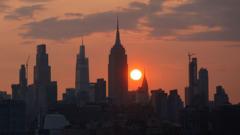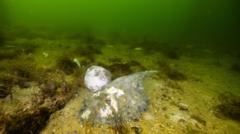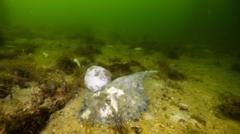Scientists warn of unprecedented coral bleaching at Ningaloo Reef, as higher water temperatures, driven by climate change, wreak havoc on one of Australia’s iconic marine landscapes.
The 'Underwater Inferno': Ningaloo Reef Faces Unprecedented Coral Bleaching Crisis

The 'Underwater Inferno': Ningaloo Reef Faces Unprecedented Coral Bleaching Crisis
An alarming marine heatwave is ravaging Australia's Ningaloo Reef, with devastating consequences for its vibrant ecosystems.
Once celebrated for its breathtaking biodiversity, Ningaloo Reef, located on Australia's north-west coast, is in dire straits due to an ongoing marine heatwave. This devastating event has resulted in significant coral bleaching, a phenomenon that turns corals white and jeopardizes the marine life that depends on them. Initially gaining attention for its unique biodiversity and serving as a popular destination for snorkelers and divers, Ningaloo is facing a crisis as the effects of climate change amplify.
The marine heatwave originates from the Caribbean and has spread across the Indo-Pacific region, culminating in this unprecedented situation. According to the Australian Marine Conservation Society’s Paul Gamblin, the current state of affairs is akin to "a raging underwater bushfire" that has wreaked havoc along Australia's coast. With both the Great Barrier Reef and Ningaloo experiencing bleaching simultaneously, this marks an alarming first for Australia.
Marine experts, including Dr. Kate Quigley from the Minderoo Foundation, are closely monitoring coral health. She compares the bleaching process to humans suffering from a stomach bug, where the crucial algae that give corals their vibrant colors are expelled from their cells due to increased water temperatures. The lack of rapid temperature recovery poses a grim outlook, leading scientists to brace for potentially drastic coral mortality rates.
While government scientists have been actively surveying the reef, the uncertainties of coral survival remain. Observations from frequent snorkelers reveal grim sights—previously vibrant seascapes are turning grey and lifeless, deeply impacting local economic activities that depend on tourism.
As part of a broader conversation about climate change, the Australian government continues to approve significant fossil fuel projects that contribute to rising ocean temperatures. The North West Shelf gas plant, poised to operate until 2070, epitomizes this dilemma, creating tension between economic growth and environmental conservation.
To combat these challenges, researchers at the University of Queensland are investigating how to better preserve Ningaloo's unique ecosystems through innovative mapping technologies. Selective breeding initiatives aim to generate more heat-tolerant coral species, although experts acknowledge the need for a systemic change to effectively address emissions and climate change.
Experts like Dr. Quigley underscore the urgency: while rapid fire responses are mobilized for forest fires, similar vigor is lacking for coral reefs, despite their essential role in sustaining marine biodiversity and supporting coastal economies. The intricate ecosystems within coral reefs not only provide habitats for marine life but also serve as natural barriers against extreme weather impacts intensified by climate change.
As Ningaloo Reef endures the consequences of an "underwater inferno," the call to action is louder than ever. The fate of these vital ecosystems hangs in the balance, demanding a concerted effort to mitigate climate change and safeguard the future of coral reefs.




















